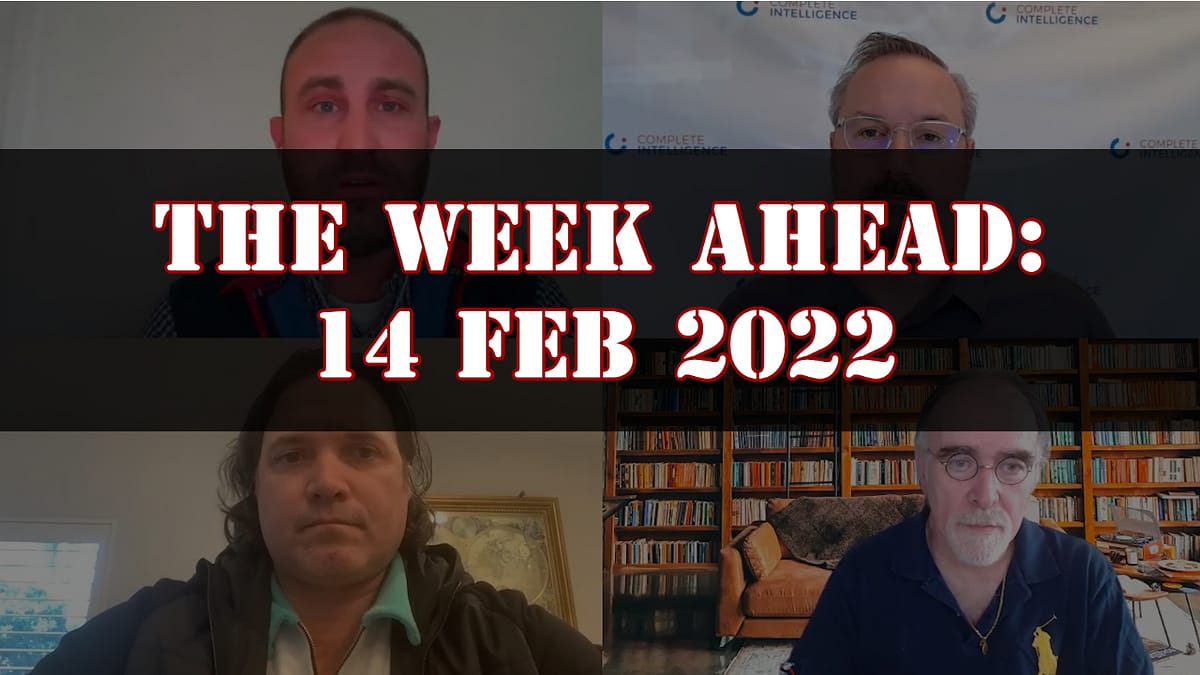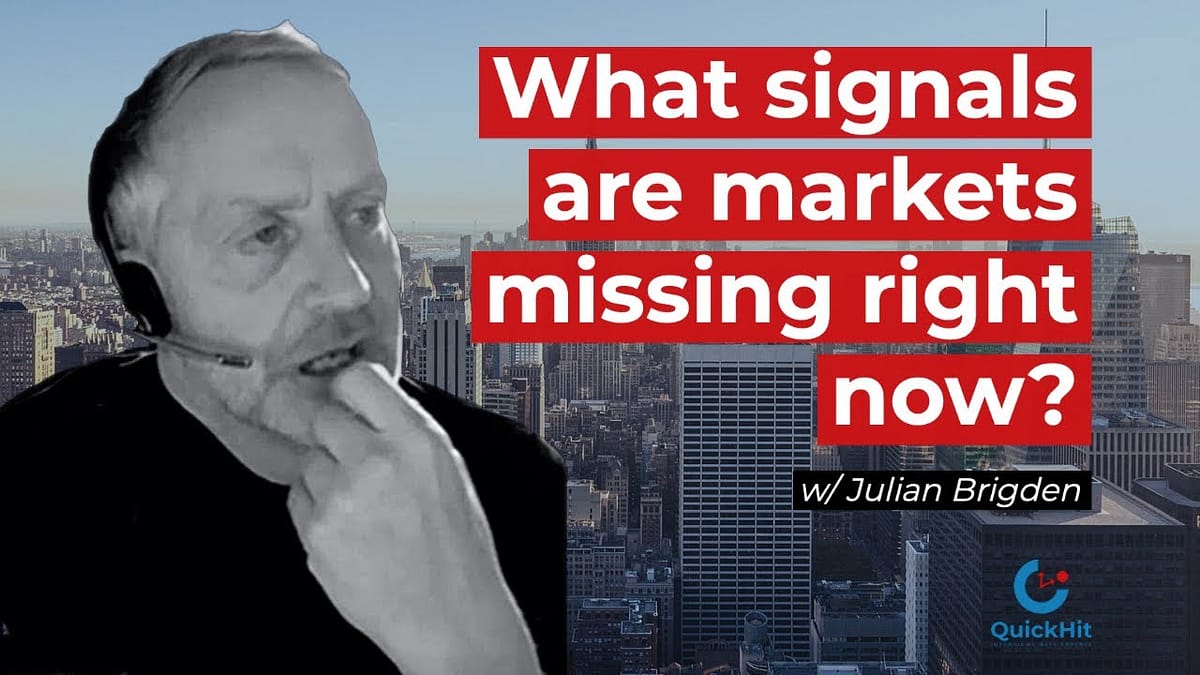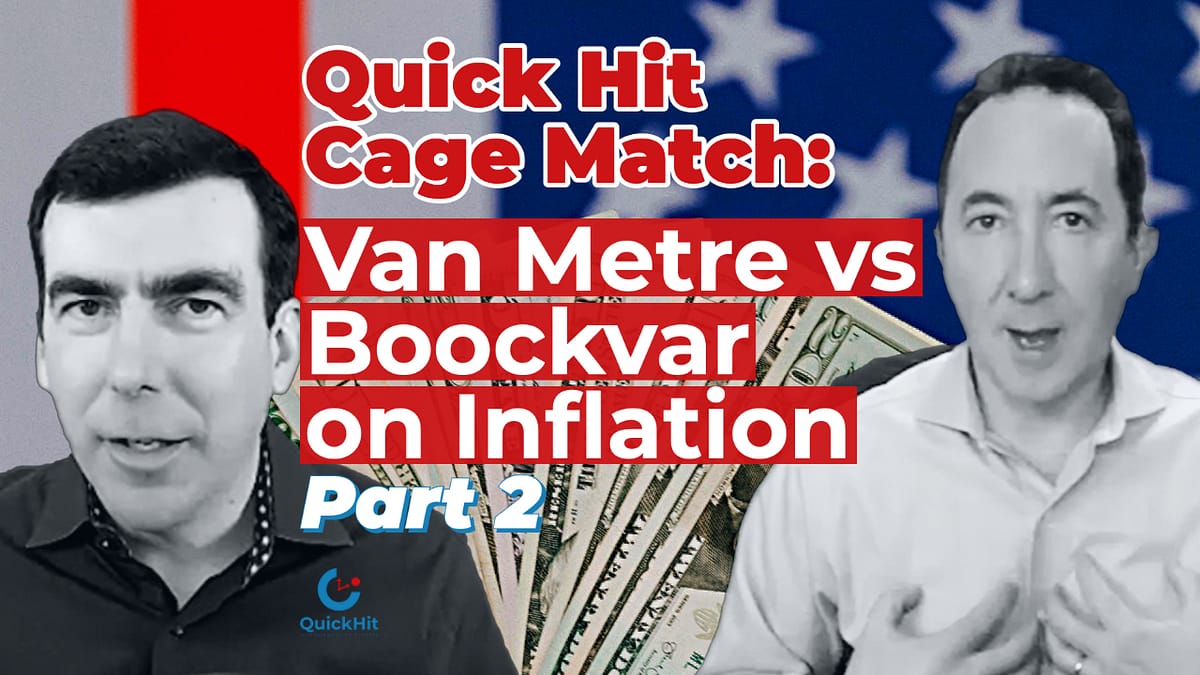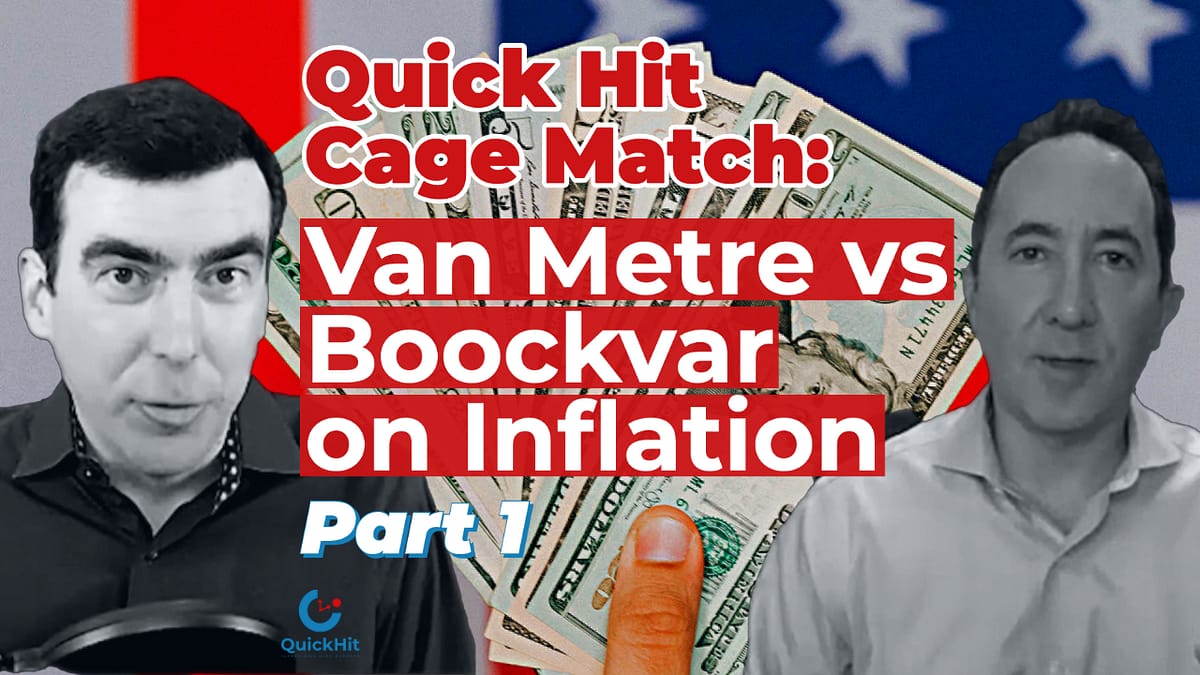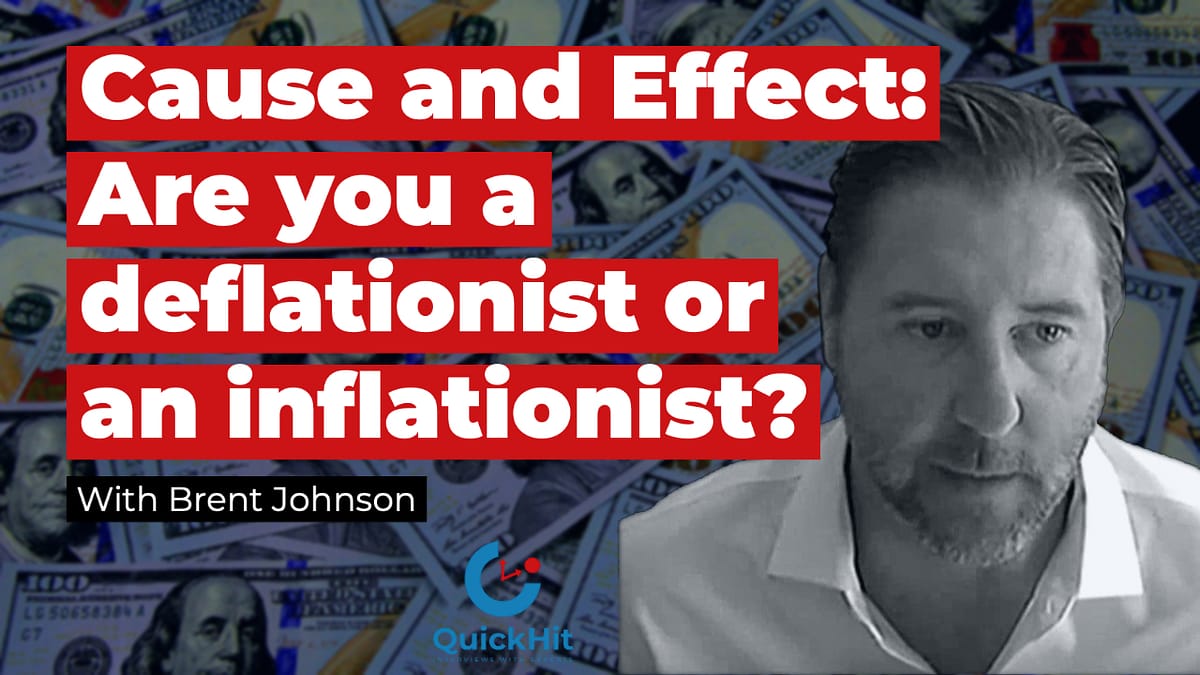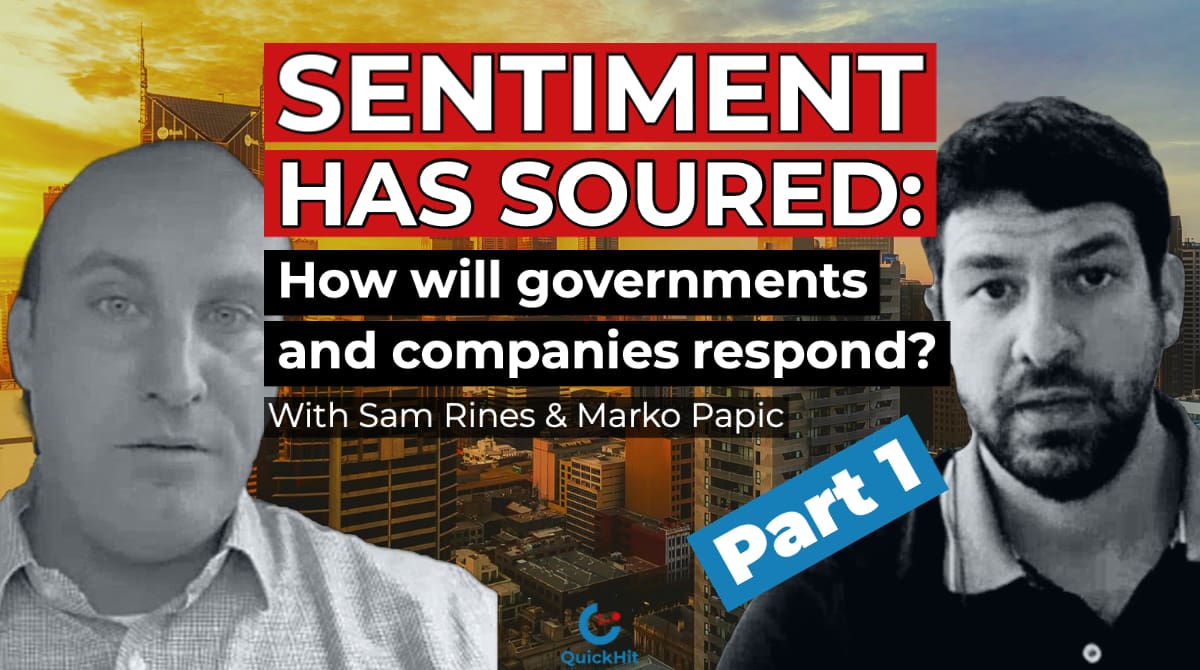‼️SPECIAL OFFER FOR THE WEEK AHEAD VIEWERS: $50/MO ON CI FUTURES SUBSCRIPTION. ‼️
We’ve seen so much about oil for rubles, gas for bitcoin, etc this week. Does it represent a fundamental shift for energy markets? And is the dollar dead? The yen fell pretty hard versus the dollar this week. Why is that happening, especially if the dollar is dead? Bonds spike pretty hard this week, especially the 5-year. What’s going on there and what does it mean?
Key themes from last week:
- Oil for rubles (death of the Dollar?)
- Rapidly depreciating JPY
- Hawkish Fed and the soaring 5-year
Key themes for The Week Ahead:
- New stimulus coming to help pay for energy. Inflationary?
- How hawkish can the Fed go?
- What’s ahead for equity markets?
This is the 12th episode of The Week Ahead in collaboration of Complete Intelligence with Intelligence Quarterly, where experts talk about the week that just happened and what will most likely happen in the coming week.
Listen on Spotify:
Follow The Week Ahead experts on Twitter:
Tony: https://twitter.com/TonyNashNerd
Sam: https://twitter.com/SamuelRines
Tracy: https://twitter.com/chigrl
Albert: https://twitter.com/amlivemon
Time Stamps
0:00 Start
0:34 CI Futures
1:22 Key themes this week
1:48 Oil for rubles (death of the Dollar?)
3:15 Acceptance of cryptocurrency?
5:34 Petrodollar Petroyuan?
7:32 Rapidly depreciating JPY
10:12 Hawkish Fed and the soaring 5-year
11:58 Housing is done?
13:10 Stimulus for energy
15:53 How hawkish can the Fed go?
17:34 What’s ahead for equity markets?
Transcript
TN: Hi, everyone, and welcome to The Week Ahead. My name is Tony Nash. I’m here with Albert Marko, Sam Rines, and Tracy Shuchart. Before we get started, please, if you can like and subscribe to our YouTube channel, we would really appreciate it.
Also, before we get started, I want to talk a little bit about Complete Intelligence. Complete Intelligence, automates budgeting processes and improves forecasting results for companies globally. CI Futures is our market data and forecast platform. CI Futures forecasts approximately 900 assets across commodities, currencies and equity indices, and a couple of thousand economic variables for the top 50 economies. CI Futures tracks forecast error for accountable performance. Users can see exactly how CI Futures have performed historically with one and three month forward intervals. We’re now offering a special promotion of CI Futures for $50 a month. You can find out more at completeintel.com/promo.
Okay, this week we had a couple of key themes. The first is oil for rubles and somewhat cynically, the death of the dollar. Next is the rapidly depreciating Japanese yen, which is somewhat related to the first. But it’s a big, big story, at least in Asia. We also have the hawkish Fed and the soaring five-year bond. So let’s just jump right into it. Tracy, we’ve seen so much about oil for rubles and Bitcoin and other things over the past week. Can you walk us through it? And is this a fundamental shift in energy markets? Is it desperation on Russia’s behalf? Is the dollar dead? Can you just walk us through those?
TS: All right, so no, the dollar is not dead. First, what people have to realize is that there’s a difference. Oil is still priced in USD. It doesn’t matter the currency that you choose to trade in because you see, in markets, local markets trade gasoline in all currencies. Different partners have traded oil in different currencies. But what it comes down to is it doesn’t matter because oil is still priced in dollars. And even if you trade it in, say, the ruble or the yuan, those are all pegged to the dollar. Right. And so you have to take dollar pricing, transfer it to that currency. And so it really doesn’t matter.
And the currency is used to price oil needs three main factors, liquidity, relative stability, and global acceptability. And right now, USD is the only one that possesses all three characteristics.
TN: Okay, so two different questions here. One is on the acceptance of cryptocurrency. Okay. I think they specifically said Bitcoin. Is that real? Is that happening? And second, if that is happening and maybe, Albert, you can comment on this a little bit, too. Is that simply a way to get the PLA in China to spend their cryptocurrency to fuel their army for cheap? Is that possibly what’s happening there?
TS: It could be. Russia came out and said, we’ll accept Bitcoin from friendly countries. Mostly, they were referring to Hungary and to China. Right. And I don’t think that is a replacement for USD no matter what because not every country except for perhaps China really accepts or El Salvador really accepts Bitcoin or would actually trade in Bitcoin. Right.
TN: In Venezuela, by the way. I think. Right. So on a sovereign basis. Okay. So Sam and Albert, do you guys have anything on there in terms of Bitcoin traded for energy? Do you have any observations there?
AM: No, this is a little bit of… This is even a serious conversation they’re having? With El Salvador going to be like the global hub for Russian oil now because they can use Bitcoin?
TN: That would be really interesting.
AM: But this is just silly talk. Every time there’s some kind of problem geopolitically and they start talking about gold for oil or wine or whatever you want to throw out, they start talking about the US dollar dying and whatnot.
I mean, like Tracy, I don’t want to reiterate what Tracy said, but her three points were correct. On top of that, we’re the only global superpower.
TN: Okay.
AM: That’s it.
SR: Yeah. My two cent is whatever on Bitcoin for a while.
TN: Right.
SR: Cool.
TN: I think that all makes sense now since we’re here because we’re already here because we all hear about the death of the petrodollar and the rise of the petroyuan and all this stuff. So can we go there a little bit? Does this mean that the petrodollar is dead? I know that what you said earlier is all oil is priced in dollars. So that would seem to be at odds with the death of the petrodollar.
AM: Well, Tony, in my perspective, the petrodollar is a relic of the 1970s. Right. Okay. Today it’s the Euro dollar. It’s not the petrodollar that makes the American economy run like God on Earth at the moment. It’s the Euro dollar. Forget about Petro dollar. Right. Because it’s not simply just oil that’s priced in it in dollars. It’s every single piece of commodity globally that’s priced in dollars.
TN: And Albert, just for viewers who may not understand what a Euro dollar is, can you quickly help them understand what a Euro dollar is?
AM: They’re just dollars deposited in overseas banks outside the United States system. That’s all it is.
TN: Okay with that. Very good.
SR: And the global economy runs on them. Full stop.
AM: It’s the blood of the global economy.
TN: So the death of the petrodollar, rise of the petroyuan and all that stuff, we can kind of brush that aside. Is that fair?
TS: Yeah. I mean, even if you look at say, you know, China started their own Yuan contract rights, oil contract and Yuan futures contract. But that still pegged to the price of the Dubai contracts. Right. That are priced in dollars.
TN: Let’s be clear, the CNY and crude are both relative to dollars. Right?
TS: Right.
TN: You have two things that are relative to dollars trying to circumvent dollars to buy that thing. The whole thing is silly.
TS: Exactly.
AM: Yeah, of course. Because Tony, the thing is, if China decides to sell all their dollars and all their trade or whatever, everything they’ve got, they risk hyperinflation. What happens to the Renminbi and then what happens in the world? Contracts trying to get priced right.
TN: Exactly. It’s a good point. Okay. This is a great discussion.
Now, Albert, while we’re on currencies, The Japanese yuan fell pretty hard versus the dollar this week. Do you mind talking through that a little bit and helping us understand what’s going on there?
AM: Yeah, I got a real simple explanation. The Federal Reserve most likely green light in Japan To devalue their yen to be able to show up the manufacturing sector in case China decides to get into a bigger global geopolitical spat with the United States. Simple as that.
TN: Great. Okay. So that’s good. This is really good. And I want people to understand that currencies are very relevant to geopolitics or the other way around. Right. Whenever you see currency movements, there’s typically a geopolitical connection there.
AM: Of course. And on top of that, if it was any other time and they started to devalue the currency like this, the Federal Reserve where the President would start calling the currency manipulators. And there’d be page headlines on the financial times.
TN: Right.
AM: And because that didn’t happen, It’s an automatic signal to me that this is what’s happening at the moment. Right.
What’s also interesting to me, Albert, is we’ve seen last week we saw Japan approach the Saudis and the Emiratis about oil contracts. We saw Japan call. There’s a meeting in Japan next week, I think, with China. So Japan is becoming this kind of foreign policy arm, whether we want to admit it or not, they’re kind of becoming foreign policy arm for the US. Because the US is not well respected right now. Is that fair to say?
AM: It’s more than fair to say, I believe Biden’s conference with South Asian leaders was just canceled on top of everything else.
TS: Sorry. And we saw this week Japan and India just signed, like, a $42 billion trade deal. So it kind of seems like they’re smoothing over the rough edges because the United States kind of came after India a little bit earlier about two weeks ago.
TN: Yeah, that’s a good call, Tracy. I think Japan and India have had a long, positive relationship. It’s especially intensified over the past, say, seven or eight years as China has tried to invest in India and the Japanese have kind of countered them and giving the Indians very favorable terms for investment and for loans. And so this is kind of a second part of that investment that was, I think, announced in, say, 2014 or 2015, something like that. And again, as we talked about it’s, Japan intervening to help the US out and obviously help Japan out at the same time. Thanks for that.
Now, Sam. We saw bonds spike pretty hard this week, especially the five year. I’ve got a Trading View source up there on the five year up on the screen right now. So can you walk us through what’s happening with US bonds right now, especially the five year?
SR: Sure. I mean, it’s pretty straightforward. The Fed is getting very hawkish and the market is adopting it rather quickly. And I don’t know how forcefully to say this. The current assumption coming from city is four straight 50 basis point hikes and then ending the year with just a couple of 25. That is a pretty incredibly fast off zero move time, some quantitative tightening, and you’re somewhere around three and a half percent to 4% worth of tightening in a year. That’s a pretty fast move.
So the two year to five years reflecting that the Fed is moving very quickly, you’re likely having the long end of the curve is lagging a little bit. You saw flattening, not steepening this week. The long end of the curve is telling you that the terminal rate may, in fact, actually be at least somewhat sticky around two and a half and might actually be moving a little bit higher. And that terminal rate is really important because that is how high the Fed can go and then stay there. It is also how fast the Fed can get there and how much above it the Fed is willing to go. So I think there’s a lot of things that happened on the curve this week.
TN: Okay. Albert, what’s in on those? Yes, go ahead, Albert.
AM: Oh, I’ve heard whispers that the long bond is going to 2.8% and maybe even 3%. That’s what the whispers have been telling me about that, which is going to absolutely devastate housing.
TN: But that was my actual idea.
SR: Oh, yeah. Housing is done. I mean, you saw pending home sales were supposed to be up a point and down 4%. That’s the first signal. The next signal will be when lumber goes back to $300.
TN: Okay. It seems to me you’re saying by say Q3 of this year we’re going to see real downside in the housing market. Is that fair to say?
SR: Oh, in Q2, you’re going to see real downside in the housing market. Yeah.
TN: Wow.
SR: Pending sales are, I think, one of the most important indicators of how the housing market is going. Right. It’s a semi forward looking indicator. If you begin to see a whole bunch of these homes in the ground stay as homes that are not being built. Right. So if you begin to see just a bunch of pads out there, it’s going to become a significant problem considering a lot of people have already bought the materials to build it off. And you’re going to begin to have some really interesting spirals that go back into some of the commodity markets that have been on fire on the housing front.
TN: Wow. Okay. That’s a big call. I love this discussion. Okay, good. Okay. So let’s move on to the week ahead. Tracy, we’ve had some stimulus announced to help pay for energy. Can you help us understand? Do you expect we’ve seen California and some other things come out? Are more States going to do this or more countries going to do this, and what does that do to the inflation picture?
TS: Well, absolutely. We saw California, Delaware, Germany, Italy talking about it. Japan already. They’re coming out of the woodwork right now. There’s actually too many to list. It’s just that we’re just now this week just starting to see the US kind of joining this on a state to state basis. The problem is that this is not going to help inflation whatsoever. You’re literally creating more demand and we still do not have the supply online. So all of these policies are going to have the opposite of the intended effect that they are doing. Right. It’s just more stimulus in the market.
TN: Do we think there’s going to be some federal energy stimulus coming?
TS: They’ve talked about different options. I mean, really, the only thing that they could do right now is get rid of the federal excise tax, but that’s only really a few cents. And they kind of don’t want to do that because that goes towards repairing roads, et cetera. That doesn’t fit into their plan that they just passed back in the fall. Right. We had infrastructure plan, so they need to pay for that. That’s already passed. So they probably won’t do that.
The other options that they have that they’re weighing are more SPR release, which is ridiculous at this point because they could release it all and it would still not have a long lasting effect on the market. And that’s our national security. It’s a national security issue. And we’re experiencing all these geopolitical events right now. We have bombs in Saudi Arabia. We’ve got Russia, Ukraine. So I think that’s like a poor move altogether.
TN: So if more States are going to come in, is it suspects like Massachusetts, New York, Illinois, those types of places?
TS: Yes.
TN: Okay. So all inflationary, it’s going in the wrong direction.
TS: It’s going to create demand, which is going to drive oil prices higher because we still don’t have the supply on the market.
TN: Okay. Wow. Thanks for that. Sam. As we look forward, you mentioned a little bit about how hawkish the Fed would be. But what are you looking at say in the bond market for the next week or so? Do we expect more activity there, or do you think we’re kind of stabilizing for now?
SR: We’re going into month end. So I would doubt that we’re going to stabilize in any meaningful way as portfolios either head towards rebalancing or begin to rebalance into quarter end. So I don’t think you’re going to see stabilization. And I think some of the signals might be a little suspect. But I do think back to the housing front. I’m going to be watching how housing stocks react, how the dialogue there really reacts, probably watching lumber very closely, a fairly good indicator of how tight things are or aren’t on the housing front.
And then paying a little bit of attention to what the market is telling us about that terminal rate. If the terminal rate keeps moving higher, to Albert’s point, that’s going to be a big problem for housing, but it’s going to be a big problem for a number of things as we begin to kind of spiral through, what the consequences of that are. It will be for the first time in a very long time.
TN: Okay. So it’s interesting. We have, say, energy commodities rising. We have, say, housing related commodities potentially falling, and we have food commodities rising. Right. It seems like something’s off. Some of it’s shortages based, and some of it is really demand push based. So energy stuff seems to be stimulus based or potentially so some interesting divergence in some of those sectors.
Okay. And then, Albert, what’s ahead for equity markets? We’ve seen equity markets continue to push higher. How much further can they go?
AM: Last week they eliminated, I think, up to about $9 trillion inputs, short squeeze, VIX crush. I mean, they went all out these last two weeks. It’s absolutely stunning. From my calculations, I think they expanded the balance sheet another $150 billion. Forget about this tapering talk. There’s no tapering. They just keep on going. How high can they go? That’s anybody’s guess right now. I think we’re like 6% off all time highs. On no news.
TN: So potentially another 6% higher?
AM: Honestly, I know that there’s hedge funds waiting, salivating at 4650. Just salivating to short it there. So I don’t think they can even get close to that, to be honest with you. So I don’t know, maybe 4590 early in the week before they start coming down.
TN: Okay. Interesting. So you think early next week we’ll see a change in direction?
AM: Yeah, we’re going to have to this has been an epic run, like I said, 90% short squeeze, 10% fixed crush. You don’t see this very often. Okay, Sam, what do you think, Sam? Similar?
SR: On equities, I like going into the rip higher. I’m kind of with Albert, but a little less bearish. I think you chop sideways from here looking for a catalyst in either direction. Bonds ripping higher today, yields ripping higher today. Bond prices plummeting. That I thought was going to be a catalyst for equities to move lower. It wasn’t. That kind of gives me a little bit of pause on being too bearish here, but it’s hard for me to get bullish.
TN: Okay.
TS: What’s interesting? I’ll just throw in like, Bama, weekly flows. We actually saw an outflow from equities for the first time in weeks. It wasn’t a lot 1.9 billion. But that says to me people are getting a little nervous up here. Profit taking, as they say on CNBC.
TN: All right, guys. Hey, thank you very much. Really appreciate the insight. Have a great week ahead.
AM, TS: Thanks.
SR: You too, Tony.
TN: Fabulous. Look. I’m married. I’m a man. I don’t notice anything. I noticed the other guys laughed at that. Uncomfortably. That’s great. Okay. I’m just going to start that over, guys. And we’re going to end it.

